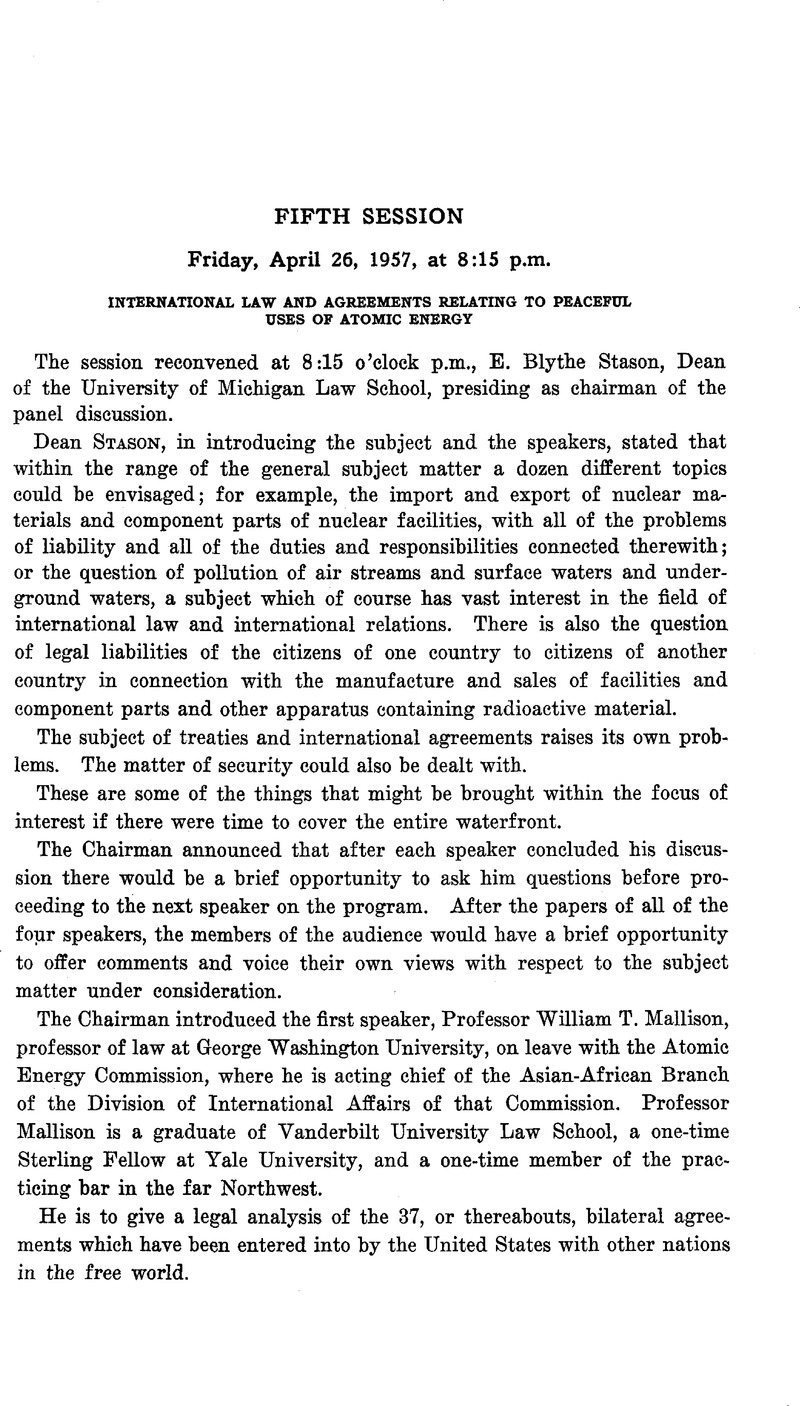Published online by Cambridge University Press: 27 February 2017

1 On the international aspect of the Atoms for Peace program, see, generally, the Atoms for Peace Manual—A Compilation of Official Materials on International Cooperation for Peaceful Uses of Atomic Energy, December 1953–July, 1955, S. Doc. No. 55, 84th Cong., 1st Sess. (1955). This useful compilation contains the texts of some of the Agreements for Co-operation.
2 Argentina, Austria, Brazil, Chile, Bepublic of China, Colombia, Costa Riea, Cuba, Denmark, Dominican Republic, Ecuador, Germany, Greece, Guatemala, Iran, Ireland, Israel, Italy, Japan, Republic of Korea, Lebanon, The Netherlands, New Zealand, Nicaragua, Pakistan, Peru, Philippines, Portugal, Spain, Sweden, Switzerland, Thailand, Turkey, Uruguay, and Venezuela. The Turkish Agreement was the first of these to be signed. 21st Semi-Annual Report of A.E.C. at p. 14 (1957).
3 Belgium, Canada, United Kingdom, Prance, Australia, The Netherlands, Norway, and Switzerland. Ibid.
4 68 Stat. 919, 42 U.S.C. 2011 (Supp. IV, 1957). See. 123 of the Act reads:
“Sec. 123. Cooperation With Other Nations.—No cooperation with any nation or regional defense organization pursuant to sections 54, 57, 64, 82, 103, 104, or 144 shall be undertaken until—
“a. the Commission or, in the case of those agreements for cooperation arranged pursuant to subsection 144 b, the Department of Defense has submitted to the President the proposed agreement for cooperation, together with its recommendation thereon, which proposed agreement shall include (1) the terms, conditions, duration, nature, and scope of the cooperation; (2) a guaranty by the cooperating party that security safeguards and standards as set forth in the agreement for cooperation will be maintained; (3) a guaranty by the cooperating party that any material to be transferred pursuant to such agreement will not be used for atomic weapons, or for research on or development of atomic weapons, or for any other military purpose; and (4) a guaranty by the cooperating party that any material or any Restricted Data to be transferred pursuant to the agreement for cooperation will not be transferred to unauthorized persons or beyond the jurisdiction of the cooperating party, except as specified in the agreement for cooperation;
“b. the President has approved and authorized the execution of the proposed agreement for cooperation, and has made a determination in writing that the performance of the proposed agreement will promote and will not constitute an unreasonable risk to the common defense and security; and
“c. the proposed agreement for cooperation, together with the approval and the determination of the President, has been submitted to the Joint Committee and a period of thirty days has elapsed while Congress is in session (in computing such thirty days, there shall be excluded the days on which either House is not in session because of an adjournment of more than three days).”
5 A.E.C. Press Release No. 936, Dec. 12, 1956.
6 1 C.C.H. Atomic Energy Law Reporter, sees. 1451–1479.
7 United Kingdom Atomic Energy Authority, Second Annual Report 1955–56 (1956), Ch. XI, Relations With Industry, sec. 168(c).
8 “Special Nuclear Material” is defined in Sec. 11 (t) of the Atomic Energy Act of 1954 as follows:
“(1) plutonium, uranium, enriched in the isotope 233 or in the isotope 235, and any other material which the Commission, pursuant to the provisions of section 51, determines to be special nuclear material, but does not include source material; or (2) any material artificially enriched by any of the foregoing, but does not include source material.”
For definition of source material, see note 13 below. Scientists quite generally refer to special nuclear materials as fissionable materials.
9 Statement by the President, The White House, Feb. 22, 1956. Since the present paper was presented on April 26, 1957, the President has made further allocations of uranium for use in reactors outside the United States. On July 3, 1957, 29,800 additional kilograms were made available. This makes a total of 50,000 kilograms which has been made available for use in foreign reactors. (An additional allocation of uranium for the United States domestic program was made at the same time and the total of the domestic allocation after the announcement of July 3, 1957, is also 50,000 kilograms.) Statement by the President, The White House, July 3, 1957.
10 Statement by the President, The White House, Nov. 18, 1956.
11 Table appended to Statement of Lewis L. Strauss, Chairman, U. S. Atomic Energy Commission, Nov. 18, 1956.
12 Note 4 above.
13 “Source material” is defined in See. 11 (s) of the Atomic Energy Act of 1954, as follows:
“(1) uranium, thorium, or any other material which is determined by the Commission pursuant to the provisions of section 61 to be source material; or (2) ores containing one or more of the foregoing materials, in such concentration as the Commission may by regulation determine from time to time.”
14 Moderator material (e.g., graphite) is used to slow neutrons in a reactor. Slow neutrons are particularly effective in causing fission.
15 “Blanketing” refers to the placing of source material outside and adjacent to the core of a reactor in order to convert the source material to fissionable material.
16 Statute of the International Atomic Energy Agency, Art. XII, IAEA/CS/13 (1956).
17 The President’s address is reproduced in full in the Atoms for Peace Manual, pp. 1–7 (cited in note 1 above).